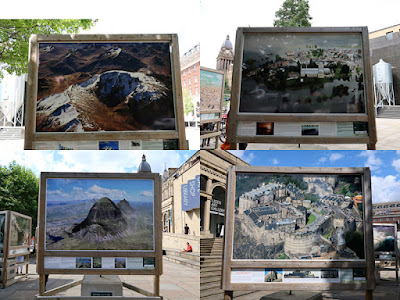 |
| The Eagle Stone |
With the exception of my day out to further explore the Sheffield Board Schools, most of my trips during August had so far been very geological and a few days after exploring Roundhay Park, I took advantage of the regular buses that run from Sheffield to Bakewell and Castleton to further explore the Peak District National Park.
Alighting from the TM Travel No. 218 bus at Clodhall Lane Crossroads, my plan was to walk along the public footpaths on the Chatsworth Grit from here to Wellington’s Monument and then continue to Fox House via Baslow Edge, Curbar Edge, Froggatt Edge and the Longshaw Estate.
Within a few minutes, I came across a Companion Stone on Eaglestone Flat, one of a set of twelve modern interpretations of the C18 guide stoops, which were erected to assist travellers across the moors. Their production involved the collaboration of various local poets and artists with landowners and were erected near to existing original guide stoops in 2010.
At the time of my walk, I didn’t know what this stone was and I didn’t make the connection with an original guide stoop on the Chesterfield Road, which is located by the track and comprises a large inscribed post made from the local gritstone.
The path runs alongside the edge of a steep woodland covered slope to the south, which falls steeply to the valley that separates it from Gardom’s Edge and down which runs the Sheffield Road to the low lying area around the River Derwent at Baslow. At one place, it is interrupted by a stream flowing from the moorland plateau, which has cut down into the boulder strewn head that covers the slopes.
To the north there is an area of heather and bracken moorland, which forms a rather monotonous landscape. Boulders of gritstone occasionally project from the vegetation and the skyline is often in the form of benches produced by the weathering of the Rough Rock and associated strata.
I next came to Wellington’s Monument, a large gritstone cross set upon an outcrop of Chatsworth Grit, which was erected in 1885 by a Dr. Wrench, a local resident who thought it was appropriate to build a monument to the Duke of Wellington, which would complement Nelson’s Monument on Gardom’s Edge.
Continuing along the path to the edge of the escarpment, where I was expecting to see the typical coarse grained Chatsworth Grit, with its seams of fingernail sized pebbles, however, I was surprised to see a series of flaggy beds exposed in the path.
The Chatsworth Grit actually comprises two leaves of sandstone separated by up to 65 metres of shale, in which are developed beds of sandstone. The thin planar bedded sandstone that I saw forms the lower part of the upper leaf and has soft partings, with the sample I collected being pale brown in colour and fine grained.
From this vantage point, there are great views of Chatsworth Park, where the River Derwent has cut through the strata that lie beneath the Chatsworth Grit, including the Ashover Grit, to leave a very pronounced valley.
I then returned to the main path towards Curbar Edge, where the Eagle Stone - an isolated tor of Chatsworth Grit - forms a very distinctive landmark that is well known to the very many walkers who have explored Baslow Edge over the years.
The public footpath doesn’t run near to the gritstone edge and I therefore quickly walked along it, taking care to avoid the ruts that have developed in places, until I came to the start of Curbar Edge, which I last visited with the Sheffield U3A Geology Group on a very wet and windy day back in November 2015.

























































